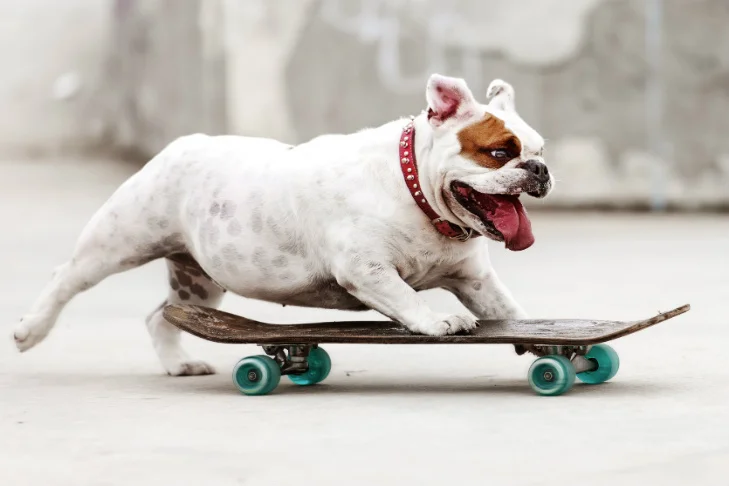As April Fool’s Day approaches, we often think about playing pranks on our friends and family. But did you know that there’s a way to celebrate this playful holiday with your furry friend while also improving their behavior and strengthening your bond? That’s right, I’m talking about trick training for dogs!
Trick training is a fun and effective way to engage with your dog, providing them with both mental and physical stimulation. Here are just a few of the many benefits that trick training can offer for both you and your pup:
- Strengthening the Bond Between You and Your Dog:
Trick training is a great way to build a stronger bond with your dog. When you engage in a shared activity like trick training, you are creating positive experiences and memories that can help deepen your relationship. Trick training also requires communication and teamwork between you and your dog, which can help to improve your communication skills and develop a greater sense of trust and understanding. - Boosting Your Dog’s Confidence:
Trick training can be an excellent way to boost your dog’s confidence. When your dog learns a new trick, they experience a sense of accomplishment. When you recognize the learning they are doing, they can gain confidence and become more willing to offer new behaviors. This can help to improve their self-esteem and reduce anxiety and behavioral issues. - Improving Your Dog’s Behavior:
Trick training can help to improve your dog’s behavior in a variety of ways. For example, teaching your dog to “stay” or “come” on command through trick training can help to reinforce good behavior and prevent bad habits from forming. Additionally, trick training can provide an outlet for your dog’s energy and reduce destructive behaviors such as chewing or digging. Teaching your dog alternative behaviors for their bad habits can prevent them from doing things such as getting into the trash, barking at people and noises, and destroying things around the house. Instead, you can teach them to bark on cue and teach a “Quiet” command so they know when it is time for noise and when to quiet down. Giving them something new to do will tire them out so they are not seeking their own entertainment in potentially destructive ways. - Providing Mental and Physical Stimulation:
Dogs need both mental and physical stimulation to stay healthy and happy. Trick training provides an opportunity for both. Learning new tricks engages your dog’s brain and provides mental stimulation, while performing the tricks requires physical activity that can help keep your dog fit and healthy. When the weather is poor outside, you can do trick training inside in small spaces with props or without any special equipment. This will give your dog a good mental workout and tire them out when they can’t go on their usual walk. - Making Training Fun:
Traditional obedience training can be repetitive and boring for both you and your dog. Trick training, on the other hand, is a fun and enjoyable way to train your dog. Trick training involves positive reinforcement and rewards, making it more likely that your dog will be enthusiastic and engaged throughout the training process. Trick training can also be a great way to inject some fun into your daily routine and spend quality time with your furry friend.
Here are some steps you can follow to teach a simple trick to your dog:
- Choose a Trick:
The first step is to choose a simple trick that you would like to teach your dog. For example, “”shake,”, “paw”, or “roll over” are all popular and easy tricks to start with. - Use praise and a valuable reward:
Positive reinforcement is key when teaching your dog a new trick. This means rewarding your dog for good behavior with treats, praise, and affection. Positive reinforcement motivates your dog to repeat the behavior that earns the reward. Use a treat your dog is fond of, such as a soft, small treat from the store, or string cheese or plain chicken can be very appealing to a pickier dog. - Break it Down:
Breaking the trick down into small steps can help your dog learn more quickly. For example, if you are teaching your dog to “sit,” you can start by luring your dog into a sitting position with a treat, and then gradually removing the treat as your dog starts to understand the behavior. - Repeat and Practice:
Repetition and practice are important for your dog to learn a new trick. Practice the trick in short sessions throughout the day, and gradually increase the duration of the sessions as your dog gets better at the behavior. - Add a Cue:
Once your dog has mastered the behavior, you can add a cue such as a word or a hand signal to indicate when you want your dog to perform the trick. For example, saying “sit” or raising your hand can signal your dog to sit. - Reward and Reinforce:
Don’t forget to reward your dog every time they perform the trick correctly. This will help to reinforce the behavior and make it more likely that your dog will repeat the behavior in the future.
Remember, teaching a new trick to your dog takes time, patience, and consistency. Start with simple tricks and gradually work up to more complex behaviors. With practice and patience, you and your dog will be able to master many fun and entertaining tricks!
As you can see, trick training has a wide range of benefits for both you and your dog. So this April Fool’s Day, instead of playing a prank on your pup, why not try teaching them a new trick instead? Not only will you both have a great time, but you’ll also be strengthening your bond and improving your dog’s behavior in the process.
Need Trick ideas? Visit AKC Trick Dog – American Kennel Club For tricks to get you started and maybe even a title.



